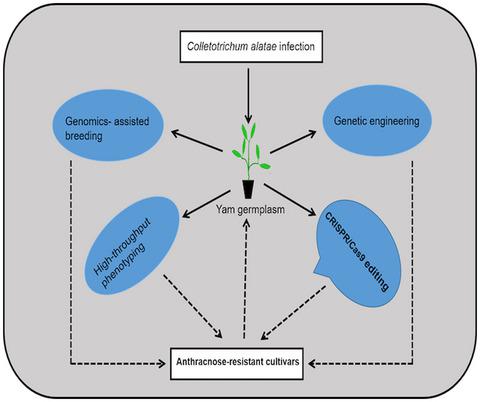当前位置:
X-MOL 学术
›
Mol. Plant Pathol.
›
论文详情
Our official English website, www.x-mol.net, welcomes your
feedback! (Note: you will need to create a separate account there.)
Strategies to combat the problem of yam anthracnose disease: Status and prospects
Molecular Plant Pathology ( IF 4.8 ) Pub Date : 2021-07-17 , DOI: 10.1111/mpp.13107 Valentine Otang Ntui 1, 2 , Edak Aniedi Uyoh 1 , Effiom Eyo Ita 1 , Aniedi-Abasi Akpan Markson 3 , Jaindra Nath Tripathi 2 , Nkese Ime Okon 1 , Mfon Okon Akpan 1 , Julius Oyohosuho Phillip 1 , Ebiamadon Andi Brisibe 1 , Ene-Obong Effiom Ene-Obong 1 , Leena Tripathi 2
Molecular Plant Pathology ( IF 4.8 ) Pub Date : 2021-07-17 , DOI: 10.1111/mpp.13107 Valentine Otang Ntui 1, 2 , Edak Aniedi Uyoh 1 , Effiom Eyo Ita 1 , Aniedi-Abasi Akpan Markson 3 , Jaindra Nath Tripathi 2 , Nkese Ime Okon 1 , Mfon Okon Akpan 1 , Julius Oyohosuho Phillip 1 , Ebiamadon Andi Brisibe 1 , Ene-Obong Effiom Ene-Obong 1 , Leena Tripathi 2
Affiliation

|
Yam (Dioscorea spp.) anthracnose, caused by Colletotrichum alatae, is the most devastating fungal disease of yam in West Africa, leading to 50%–90% of tuber yield losses in severe cases. In some instances, plants die without producing any tubers or each shoot may produce several small tubers before it dies if the disease strikes early. C. alatae affects all parts of the yam plant at all stages of development, including leaves, stems, tubers, and seeds of yams, and it is highly prevalent in the yam belt region and other yam-producing countries in the world. Traditional methods adopted by farmers to control the disease have not been very successful. Fungicides have also failed to provide long-lasting control. Although conventional breeding and genomics-assisted breeding have been used to develop some level of resistance to anthracnose in Dioscorea alata, the appearance of new and more virulent strains makes the development of improved varieties with broad-spectrum and durable resistance critical. These shortcomings, coupled with interspecific incompatibility, dioecy, polyploidy, poor flowering, and the long breeding cycle of the crop, have prompted researchers to explore biotechnological techniques to complement conventional breeding to speed up crop improvement. Modern biotechnological tools have the potential of producing fungus-resistant cultivars, thereby bypassing the natural bottlenecks of traditional breeding. This article reviews the existing biotechnological strategies and proposes several approaches that could be adopted to develop anthracnose-resistant yam varieties for improved food security in West Africa.
中文翻译:

山药炭疽病防治策略:现状与前景
山药炭疽病是由炭疽菌引起的,是西非最具破坏性的山药真菌病害,严重时会导致块茎产量损失50%~90%。在某些情况下,植物在没有产生任何块茎的情况下死亡,或者如果疾病早期发作,每个枝条可能会在死亡之前产生几个小块茎。C. alatae影响山药植物各个发育阶段的所有部位,包括山药的叶、茎、块茎和种子,在山药带地区和世界其他山药生产国高度流行。农民采用的传统方法来控制这种疾病并不是很成功。杀菌剂也未能提供持久的控制。尽管传统育种和基因组学辅助育种已被用于在薯蓣中产生一定程度的炭疽病抗性, 新的和更强毒株的出现使得开发具有广谱和持久抗性的改良品种至关重要。这些缺点,加上种间不相容、雌雄异株、多倍体、开花不良以及作物育种周期长,促使研究人员探索生物技术技术来补充常规育种,以加快作物改良。现代生物技术工具具有生产抗真菌品种的潜力,从而绕过了传统育种的自然瓶颈。本文回顾了现有的生物技术战略,并提出了几种可用于开发抗炭疽病山药品种以改善西非粮食安全的方法。
更新日期:2021-09-12
中文翻译:

山药炭疽病防治策略:现状与前景
山药炭疽病是由炭疽菌引起的,是西非最具破坏性的山药真菌病害,严重时会导致块茎产量损失50%~90%。在某些情况下,植物在没有产生任何块茎的情况下死亡,或者如果疾病早期发作,每个枝条可能会在死亡之前产生几个小块茎。C. alatae影响山药植物各个发育阶段的所有部位,包括山药的叶、茎、块茎和种子,在山药带地区和世界其他山药生产国高度流行。农民采用的传统方法来控制这种疾病并不是很成功。杀菌剂也未能提供持久的控制。尽管传统育种和基因组学辅助育种已被用于在薯蓣中产生一定程度的炭疽病抗性, 新的和更强毒株的出现使得开发具有广谱和持久抗性的改良品种至关重要。这些缺点,加上种间不相容、雌雄异株、多倍体、开花不良以及作物育种周期长,促使研究人员探索生物技术技术来补充常规育种,以加快作物改良。现代生物技术工具具有生产抗真菌品种的潜力,从而绕过了传统育种的自然瓶颈。本文回顾了现有的生物技术战略,并提出了几种可用于开发抗炭疽病山药品种以改善西非粮食安全的方法。











































 京公网安备 11010802027423号
京公网安备 11010802027423号